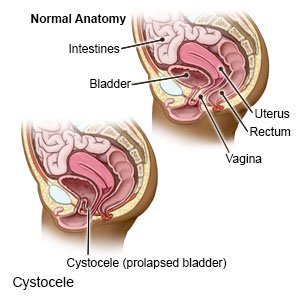Cystocele
Medically reviewed by Drugs.com. Last updated on Aug 4, 2025.
What is a cystocele?
A cystocele is a condition that causes part of your bladder to fall into your vagina. Weakened or stretched pelvic muscles are no longer able to hold the bladder in place. Your bladder may begin to slip through your vaginal opening.
 |
What increases my risk for a cystocele?
- Pregnancy and childbirth
- Lower estrogen levels from older age or menopause
- Anything that strains your pelvic muscles, such as obesity, chronic constipation or straining during bowel movements, severe coughing, or lifting heavy objects
- Pressure in the pelvic area from a prolapsed bladder, rectum, or uterus
- A hysterectomy or other pelvic surgery
- A collagen disease, such as Marfan syndrome
What are the signs and symptoms of a cystocele?
- A soft bulge or lump in your vagina
- Low back pain that is relieved when you lie down
- Pelvic pain or pressure, especially when you urinate or have sex
- Pink or red urine
- Pressure in your abdomen, or you feel that you cannot completely empty your bladder
- Difficult, painful, or frequent urination, especially at night
- Urine leaks out when you cough, sneeze, or laugh
How is a cystocele diagnosed?
Your healthcare provider will ask about your health history. This includes your lifestyle, past pregnancies, and any health conditions you have. You may need one or more of the following tests:
- A pelvic exam is used to check your bladder and structures around it. As you strain or bear down, your healthcare provider will be able to check the location and size of your cystocele. Your provider may also test the strength of your pelvic muscles.
- Cystoscopy is used to check your bladder for stones, bleeding, tumors, or signs of infection. A thin tube with a scope is inserted into your urethra and moved up into your bladder.
- Blood and urine tests may be used to check for an infection.
- An ultrasound, x-ray, or MRI may show problems with the area around your bladder. You may have x-rays taken while you urinate. Contrast liquid may be used to help your bladder show up better in pictures. Tell healthcare providers if you have ever had an allergic reaction to contrast liquid. Do not enter the MRI room with anything metal. Metal can cause serious injury. Tell providers if you have any metal in or on your body.
- Urodynamics is a test to check if the muscles of your bladder are working properly. It also measures how much urine your bladder can hold. This test can also show whether your bladder fills and empties in a normal way.
Related medications
How is a cystocele treated?
Depending on your symptoms, you may need any of the following:
- Estrogen may help strengthen the pelvic muscles and keep your cystocele from getting worse. This may be taken as a pill, applied as a cream, or inserted into your vagina.
- A pessary or tampon can be placed inside the vagina to support the bulging tissues in your bladder and vagina. A pessary is a plastic or rubber ring and a tampon is a plug of cotton or other absorbent material.
- Surgery may be needed to lift your bladder back into place. Stitches or a mesh patch may be placed between your bladder and vagina to hold your bladder in place.
What can I do to manage or prevent a cystocele?
- Do Kegel exercises regularly. These exercises can help your pelvic floor muscles get stronger. Tighten the muscles of your pelvis (the muscles you use to stop urinating). Hold the muscles tight for 5 seconds, then relax for 5 seconds. Gradually work up to holding the muscles for 10 seconds. Do at least 3 sets of 10 repetitions a day.
- Do not strain. Do not lift heavy objects, stand for long periods of time, or strain to have a bowel movement. Prevent constipation by drinking plenty of liquids and eating foods high in fiber. Ask how much liquid to drink every day and which liquids are best for you. High-fiber foods, such as fruits, vegetables, and whole grains, soften bowel movements. This helps bowel movements pass more quickly through your colon. Slowly add fiber into your diet to avoid bloating, stomach pain, and gas.

- Maintain a healthy weight. Ask your healthcare provider what a healthy weight is for you. Your provider can help you create a weight loss plan, if needed. Your provider can also help you create a physical activity program. Physical activity, such as exercise, helps your bowels work better and decreases pressure inside your colon.

- Keep a record. Record the number of times you urinate each day. Describe the color and amount of your urine. Bring the record to your follow-up visits.
When should I seek immediate care?
- You have bleeding from your vagina that is not your monthly period.
- You have a mass bulging out of your vagina that you cannot push back in.
- You have severe lower abdominal pain.
- You have a bad-smelling discharge coming from your vagina.
When should I call my doctor?
- You have a fever.
- You have chills or feel weak and achy.
- You have lower abdominal pain or back pain that does not go away.
- You cannot urinate.
- You have questions or concerns about your condition or care.
Care Agreement
You have the right to help plan your care. Learn about your health condition and how it may be treated. Discuss treatment options with your healthcare providers to decide what care you want to receive. You always have the right to refuse treatment. The above information is an educational aid only. It is not intended as medical advice for individual conditions or treatments. Talk to your doctor, nurse or pharmacist before following any medical regimen to see if it is safe and effective for you.© Copyright Merative 2025 Information is for End User's use only and may not be sold, redistributed or otherwise used for commercial purposes.
Further information
Always consult your healthcare provider to ensure the information displayed on this page applies to your personal circumstances.
